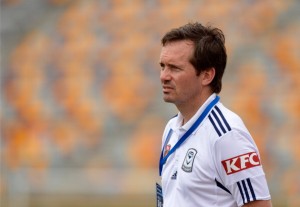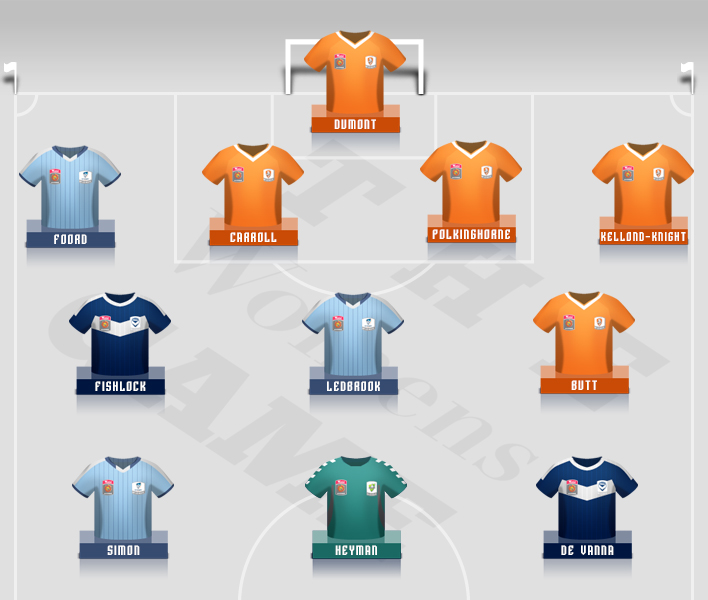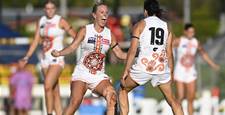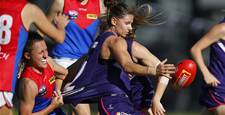When the final whistle blows on Monday afternoon in Sydney, it will bring down the curtain on Alen Stajcic's W-League career.
When the final whistle blows on Monday afternoon in Sydney, it will bring down the curtain on Alen Stajcic's W-League career.
The last of the inaugural coaches, Stajcic has been a mainstay of the competition in his six and a quarter seasons.
Along the way his teams have played some of the most attacking and exciting football in a discernible style and quality, he has developed some of the most recognisable Australian stars, garnered fierce loyalty but also divided opinions of W-League community.
He has also undeniably been very successful.
As he leaves the league, he leaves behind a considerable record including coaching in 75 matches (61% win record), outlasting 15 coaches, qualifying for 6 semi finals, contesting 3 grand finals, winning 2 champions and 2 premierships, third place in the International Women's Club Championship and 2 W-League Coach of the Year awards.
We caught up with "Staj" to discuss his time in the W-League.
What are your thoughts as you prepare a Sydney FC side for the final time?
I haven't really thought about it to be honest. I am more just worried about the game and just know how hard this game will actually be.
I think Melbourne have played the best football out of anyone so far, in terms of the opposition we are playing against, so we haven't really talked about it or thought about it.
I guess I will worry about more after the game on Monday.
Looking back on formation of the league, what were your hopes for it?
Coming from the old national league, when we sat down and discussed with Tommy [Tom Sermanni] and others, we knew we needed a league.
Firstly, to keep some of the older players still in the game and secondly, to foster some of the younger players coming through.
We knew that a league was essential to this, and one that was probably stronger than the past one. The fact that we got TV rights on board and quality internationals early really gave the league a bit of a boost.
That first season, when you look back at it, how do you rate it in terms of cementing the foundations of the W-League today?
It was critical. A lot of players who were maybe thinking of retiring from football kept playing.
 Former players like Joey Peters key to the league early | Photo: Getty Images
Former players like Joey Peters key to the league early | Photo: Getty ImagesPlayers like Cheryl Salisbury, Joey Peters and Diane Alagich played on longer and passed on some of their knowledge and skills to the young players coming through the ranks. In terms of that I think we achieved a lot.
There were a lot of players who stayed back and played an extra one, two or even three seasons in the W-League who might have otherwise departed if we didn't have anything there.
The foundations were really set there for the kids that are coming through today and we really have to acknowledge those players who were the foundation members of that competition.
Sydney FC and Brisbane Roar dominated early but slowly we have seen the emergence of other clubs/states. How have you seen the league in terms of evening out the talent in Australia?
It was obviously crucial. In the old national league Victoria was fairly weak and to see the rise of Melbourne Victory and the players that have come through there has been great.
Adelaide has taken a lot longer but the players that are coming through in the last two or three years has been fantastic as well and they are starting to get lots of numbers in the U17s and Young Matildas.
The fact that Sydney and Brisbane are diminishing in terms of how important they are is essential for the success of the Matildas. We really need Perth, Adelaide, Canberra and Melbourne to be strong areas of development and, in saying that, keeping Sydney and Brisbane as strong as we can as well.
However, there is still a lot of work to do and I think the centres have room for improvement in developing young players to make sure that we keep up with the world trends and the pace of development of the modern women's game.
One of the key features of the W-League was the cap on internationals (3 per team), what were your thoughts on the cap and how it has impacted on the league?
I think the balance is almost perfect at the moment. We don't want too many more than 3 taking up the spots of young Aussie players who can come through.
Firstly, I think the internationals have been a good equaliser.
You just look at Melbourne; you take out their internationals last year or this year and they certainly lose a lot of impact. It would certainly weaken a lot of teams if you take out their internationals.
Secondly, most of the internationals teams have brought in have been fantastic players and have just added so much quality to the game.
So much that their own teammates can learn from them but so can the opposition. Jess Fishlock springs to mind as the ultimate professional on and off the field. Someone who is a great person to have on your team but also a great challenge for opposition players.
Thirdly, the leadership is also important. We had someone like Catherin Paaske who was brilliant at Sydney, someone like Keelin Winters today at the Wanderers; these players are just crucial for the development of our game.
While the standard of play has improved season after season, some of the post W-League structures have diminished. What structures need to be around the W-League to continue it, and the players, to grow?
 Lisa De Vanna a constant challenge for Stajcic and Sydney | Photo: emily Mogic Photography
Lisa De Vanna a constant challenge for Stajcic and Sydney | Photo: emily Mogic PhotographyIt is extremely important that the training structures in non W-League time are brought back up to standard. In the last year or two that has maybe waned a little bit.
It is more per needs basis on what is going on in a specific city; Sydney has declined a little but Adelaide and Brisbane still have some strong structures in place.
The top, world class, best case training environment we can produce in each city is essential. At the end of the day, the players are only in W-League for 4, 5 months maximum so there is a good 7 months where our elite players aren't in the W-League environment. That is the major block of training for our elite players and potential players.
What would you like to see next in the evolution of the W-League?
Having two full rounds in the first starting point. I would like to see more capital and more resources put in by all the teams and clubs.
Third, it would nice to have 8 participants who are all strong to be in there and maybe even opening it up to clubs who want to come in. Potentially also to have a bidding process and make it an in-demand league.
It would just be great if we could have a parent body who would be keen to pump in a lot of resources into the W-League. That means coaching resources, on field and off field, and including money to bring out the best players.
"Having the best of everything would be excellent and having clubs, institutes, federations, who really want to provide the ultimate elite experience is where we have to aim for."
Which moment stands out for you in your 7 seasons?
There's been a lot. Going to the Club World Championship was fantastic.
We will rue the day forever we lost the semi final to Chelsea as we really could have won that game 4 or 5-0, that's how much stronger we were. We just couldn't put away our chances and got punished by a world class counter attacking team.
"The whole experience of taking club team over there [IWCC] and competing against some of the best clubs in the world just showed and re-enforced how good our league is."
At the end of the day I know that Sydney FC was equal in terms of ability and talent to Brisbane, Melbourne or Canberra. That gives me great confidence going forward in terms of the W-League and as a national coach as well.
Most challenging player to come up against?
The hardest player we came up against is definitely Lisa De Vanna. Whether she is hot or cold, she is always dangerous.
She is dangerous the whole game when she is hot and dangerous when she is cold because she unpredictable and just pops. She has always been a thorn in our side and always seems to step it up against a Sydney FC team.
Even last year Jess Fishlock is close to being the best import we have played. I would have her a close second.
 Stajcic enjoyed the battles with Mike Mulvey | Photo: Getty
Stajcic enjoyed the battles with Mike Mulvey | Photo: GettyYou have come up against a lot of coaches. Who did you most enjoy matching wits with?
There were lots of coaches and even going back to the old national league Mike Mulvey was always a great person to play against. Loved having duels against him and we probably ended up 50/50 on the ledger.
It was just great to talk football with Mike after the game and analyse the game. He was always a great challenge.
The quality of the coaching has improved again this year and that is sometimes forgotten but an important aspect of the game.
Staj's XI
Alen Stajcic nams the eleven players (and second XI) he thinks have provided the greatest impact and been the most influential players in the W-League.
Second XI: Lydia Williams, Laura Alleway, Renee Rollason, Ellie Brush, Steph Catley, Teresa Polias, Katrina Gorry, Caitlin Munoz, Jodie Taylor, Sam Kerr, Leena Khamis
Influential XI notes:
| Casey Dumont (GK): | Won three penalty shootouts in a semi final to get a team to a final. Season 3 Grand final made 2 or 3 saves and was my player of the match. Contributed to Brisbane making so many grand finals |
| Caitlin Foord: | The most powerful, dynamic and explosive right back and probably the biggest threat to the opposition |
| Clare Polkinghorne / Kim Carroll: | Have been the two most consistent and big contributors to Brisbane's success and strong defensive record |
| Elise Kellond-Knight: | Tight been Steph Catley and KK. KK contributed over a longer period and always showed up for big matches |
| Kylie Ledbrook: | Big part of Sydney FC's attack whether she scored herself or set them up. Great work rate, rally knows the game, tough player and probably most creative player over the history |
| Jessica Fishlock: | Arguably the best import. So dangerous, always involved and big part of Melbourne Victory's title |
| Tameka Butt: | One of biggest threats for Brisbane Roar over the course of the league. Always positive, backs herself and consistently comes up with big goals. She is the player we looked to stop |
| Michelle Heyman: | Leading goalscorer of all time. Vital for Canberra United and contributed to their premierships and championship |
| Lisa De Vanna: | Explosive, unpredictable and is a big part of her teams being semi final or grand final contenders |
| Kyah Simon: | A creator of play and a threat all the time. Has scored some unbelievable goals. |
Related Articles
.jpeg&h=172&w=306&c=1&s=1)
Belief high for Jets ahead of City ALW semi-final clash

Glory have eyes on the prize after hot six-match run
.jpeg&h=172&w=306&c=1&s=1)













